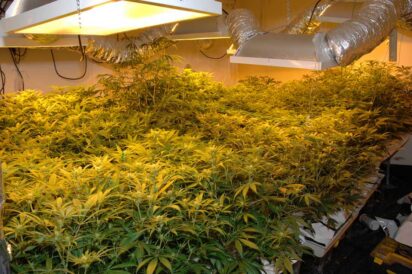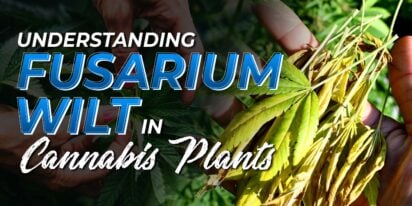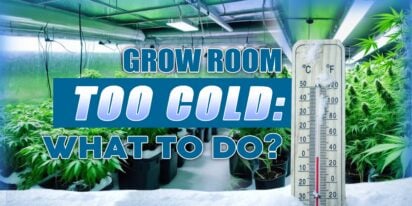
Are You 18 Or Over?
YesOr
No By clicking yes, you certify that you are over 18. By using this website, you agree to our legal disclaimer.605+ Cannabis Strains over 20 Breeders worldwide.
Table of Contents

In the industry of cannabis, you would notice that new innovations in technology are delivered in the market each day. More and more methods and devices are introduced to the market, all aiming to provide potential efficiency. An illustration, when discussing about the cheaper method of growing cannabis indoor, LEC grow lights are the perfect answer. You will soon understand the promising benefits of LEC lights after learning its basics.
Enhanced technology can be a guarded purchase, particularly if the outputs are yet to be seen. This is particularly crucial because you do not want to spend for something that will not justify your expenses. You do not want to pay for something that will not work well in return. Delightedly, as the consumption of LEC lights have become very popular, information pertaining to their capability and competence to enhance the harvest are captivating a large number of gardeners. These growers were exposed to the different types of grow lights but see the potential of LEC lights over the rest.
It appears like for every day that has passed, an innovative technology or an alternative bit of device comes out to participate in the cannabis scenery assuring excelling yields or lowered expenses. Similar to all things that we encounter in life, these kinds of declarations are easily said, but hardly issued with a support. If, nonetheless, economical growing surroundings seem like an interesting subject to tackle, the LEC grow lights can be the consequent step offering solutions for future-fit lighting.
With an expanded lumen per wattage, the commitment to upgrade the yield together with a more unrefined light spectrum, the data abaft LEC – or more commonly recognized as the CMH lights, absolutely appear to smash. But is it worth contemplating though? What are the restrictions does the occurring lighting stores have which turns an enhancement beneficial?
Nowadays, if you choose to grow from indoor, adequate lighting is necessary to energize the method of photosynthesis. Basic choices can be broken down into four main classifications, namely: metal halide (MH), fluorescent grow light (CFL), high-pressure sodium (HPS), and the light-emitting diode (LED).
Primarily, the CFLs are the most commonly used by neophyte growers only concentrating on a limited number of plants. These lights are hugely accessible in hardware stores, generate a medium quantity of light. They are methodically competent of taking the seedlings all throughout the stage of harvest provided that the remaining growing environment is in excellent shape. Granted that they are a basic household device, the age of these lights shall be intermittent, but generally they give a conservative accomplishment. CFLs are commonly not suggested for the phase of flowering if you can manage better, because they are commonly too sluggish to generate a plentiful yield.
The MH and HPS lights, on the other hand, create the pillar of structures for recreation gardeners thoroughgoing to large-scale commercial works. The aforesaid is recommended during the phase of vegetation as the latter is suggesting during flowering phase. Regardless of their various usage, the two possess something in standard – amazingly high operating expenses. And as the two lights are capable for improved yields, while the industry approaches to a decisive and eco-friendly access, the MH and HPS lights seem very outmoded.
Putting in mind the new kid in the block, the LED lights provide the entire light spectrums accessible from the bulbs mentioned above, however not having the combined operating expenses or heat produced. These lights are rapidly turning the top pick while growers discern to conform their distinction. That was the scenario then, until the LECs or the light-emitting ceramics landed on the scenery.
The bottom line of the issue – what are these LEC lights? What makes them appealing to many growers? Why is it that LECs are once in a while named as ceramic dischare metal halide (CDM) or ceramic metal halide (CMH)? Delightedly, these terms correspond to the same meaning, and as the knowledge of automation enhances, these terms have been compatible. I know that these terms may be confusing to you but this article will try to enlighten you:
LEC lights use a kind of ceramic arc tube, instead of the quartz variation seen in common MH lightings. The output brings a more unrefined color, generating further lumens for every watt and enduring a longer period. LEC fixtures have various models. The most familiar model is the 315W characterized with a 4200K color bulb.
LEC 315 model, being the most frequent dimension of LEC lights, has an average yield of five to ten ounces, although some planters even get a much higher yield. These models are kept around eighteen inches from above the plants.
This design of grow lights is turning progressively famous for indoor cannabis growers.
When discussing about the distance, you must know that the LEC lights generate an intensely strong lighting and commonly require to be placed additionally far from the plants than HPS or MH lightings of the same wattage.
Ideal Illustration:
| LEC Wattage | Ideal Distance from the Plant |
| 315W | 18”-20” or more |
| 630W | 24”-26” or more |
Note that it will be ideal to place your LEC lights an extra of six to twelve inches away from the immature plants until they reach few weeks of age, or if you notice indication of mild stress.
Having a very tough rivalry among LEDs, an apparently comprehensive solution for lighting, what advantages will LEC lights give?
If you have participated in cannabis growing, you are familiar with light wavelengths and determine what kind of wavelength will be ideal for a specific growth phase. Violet, ultra-violet, blue wavelengths are shorter. They are also heavier with energy. On the other hand, red, far-red, orange wavelengths are longer, but they are less heavy with energy.
Given the fact that shorter wavelengths are more effective, they are mostly ideal for vegetative growth. Longer wavelengths, on the other hand, imitates late summer as well as fall, perfect for the flowering phases.
LEC lights possess all types of wavelengths. This means that you do not have to replace any bulbs until they blast, which is approximately every two years. Yes, they will not endure longer as the LED lights, but will certainly well encourage excellent flourishing.
Moreover, LEC built-in ballasts make use of a more effective square wave frequency which leads to a more polished, more effective fire rate.
Its light can be fuller and brighter, but it still eludes minimal heat than the typical HPS grow lights.
For neophytes, the color or shade of light generated by this newest improvement is considerably more common. The result is, it turns much more doable to find the ordinary color of the cannabis during the whole of its lifecycle. It may not appear significant; however, it can be essential for analyzing the progress of the growth of your plant and if there are certain concerns which can be determined rapidly by the shifts in color.
Now, understanding a situation, the HPS lights emanate an extreme yellow light, while the LEDs commonly emanate purple hue.
That specific light spectrum emanated by the LEC fixtures also exhibit another point of understanding. The LEC lights emanate UV-B rays, which based to the informal accounts, develop the rendering of trichome of cannabis while in the phase of flowering. The output is a discerned boost in harvests, nonetheless, the decision on how great it develops harvest is still hugely figured out.
Another advantages of LEC lights are their plug-and-play nature and longevity. They have innate ballasts; therefore, the setup is very doable. Certain manufacturers assert that LEC lights can stay up to two years, which is considerable lengthy than any alternatives, except for LED.
Of course there are perfect lighting solutions! Even the LEC lights have their disadvantages. The emanated UV-B rays are dangerous to the human beings. Tolerable safety device is required to lessen any hazards to the eyes or skin. Nowadays, the high structure expenditure of LEC can be repulsive. Since the technology is fresh, their price is significantly higher compared to the conventional bulbs such as CFLs, though this characteristic is fairly of a sharp sword. The primary amount is higher, however, the indelible running expenses lie in between the HPS and LED lightings.
Further, LECs emanate immense heat. It is unbefitting the HPS or the MH lights, however sufficient to guarantee ample airflow as well as cooling alternatives further conceivably contributing to the founding cost if you are not yet owning a ventilation device. Another thing to consider is the placement of LEC lights versus HPS light. The LEC lights do not completely counterpart similar intensity of light of HPS assortments, hence you will have to place the fixture nearer to your cannabis’ canopy. Finally, glass blocks UV-B rays emanated by the LEC bulbs. Planters would have to think again any interferences in between the lightings and the plants.
The reality is that the LEC lights are significantly new and possibly not completely tested by the growers. You can utilize all available information which will give you promising details.
The advantages of LEC lights seem to dominate majority of its disadvantages. Enhanced yields with lesser watts mixed with UV-B rays and lessened operating expenses, the genuine opponent of LEC is actually only LED. Although LED lights give the same advantages without the augmentation of extra heat, currently, they cannot equal the enhanced yields which the LEC lights offer. If you intend to plant cannabis in the coming days, you will potentially get a favorable return if you consider investing with LEC fixtures. If your structure for HPS or MH perishes, today can be the right time to make a new investment – something that is newer and more competent.

In recent years, the discourse surrounding secondhand marijuana smoke has gained significant attention, paralleling the legalization and increas

In the realm of cannabis culture, the practice of "wake and bake" holds a significant place, accompanied by both supporters and skeptics. As exp

Introducing the robust indica strain known as Critical Mass weed, a harmonious fusion of Afghani and Skunk #1 genetics. Delve into its essence,

Fusarium wilt cannabis represents a significant threat to cannabis cultivation, necessitating a comprehensive understanding of its intricacies.

1980s were a time of profound cultural transformation, marked by iconic fashion, music, and movies. Alongside these trends, a unique facet of '8

[ez-toc] In the deep history of cannabis cultivation, there exists a captivating and creative practice that combines the art of cultivation wit

For growers looking to get better yields and healthier cannabis plants, it's important to understand and control the cannabis soil pH levels. pH

[ez-toc] In indoor gardening, maintaining an optimal temperature within your grow tent is crucial for the health and productivity of your plant

[ez-toc] Welcome to the delightful world of cannafudge crafting, where sweetness meets sophistication, and cannabis infusion adds a unique twis

[ez-toc] You’ve finished trimming your weed, but what about those leftover stems? Don’t throw them away! These seemingly useless bits can a

Are You 18 Or Over?
YesOr
No By clicking yes, you certify that you are over 18. By using this website, you agree to our legal disclaimer.